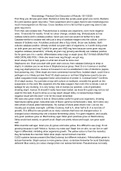Summary
Summary BS5100 Practical Notes
- Institution
- University Of East London (UEL)
An in-depth guide on the practicals undertaken in BS5100. The first practical is visualising the cells under light microscopy, and doing catalase and oxidase biochemical tests. The NBT assay is next, which highlights how phagocytosiscan occur and its consequences. The clinical features of CGD is al...
[Show more]



